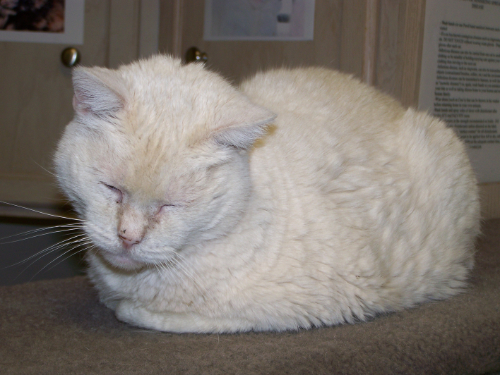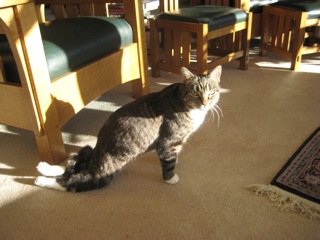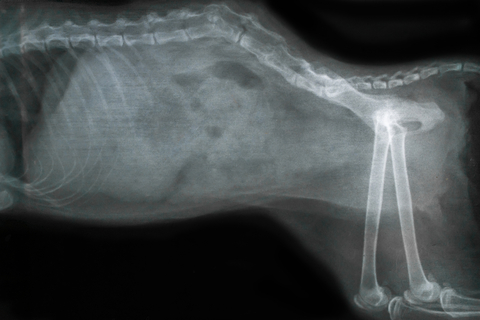What is back pain in your cat?
Presumably everyone knows what back pain can feel like. We all suffer from it sometimes. So do cats. If your cat has back pain, there are some nerves in his back that register a pain sensation and transmit it to his brain. To try to reduce the pain, his brain starts thinking about what needs to be done to get rid of the pain. In this way, your cat then performs an action so that it can escape the pain.
For example, if your cat has pain in his back because he is lying in the wrong position, his brain tells his body to lie differently. If he has pain in his back because of a hot radiator, his brain tells him to go somewhere else. This way your cat will get rid of the pain he experiences. But unfortunately, in some cases he can hardly do anything to relieve his pain.

What do cats do when they have pain in their back? What is your cat's position when it is in pain?
You can recognize a cat with back pain because it keeps its back very stiff. You often see a rounded back at that moment. But a cat also regularly keeps its back in a hollow form. Like his back seem to have collapsed at that moment. In this way, your cat tries to reduce the pressure on its back and thus feel less pain. To counteract the pain, they will climb or jump less and their movements will be slower and more thoughtful. And of course they decide to become less active, but to lie quietly.
They can also tense their abdominal muscles to distribute the force on their back more across the body. His belly feels hard and stiff at that moment.
Some cats also become less potty trained. This is especially the case when they have a small litter box and they can no longer bend properly to defecate. They often decide to defecate outside the litter box.
And of course, cats can moan or hiss when they feel a twinge of pain or when you want to pet them. They may even bite you. If they are still able to be so flexible, they can also lick or bite their back excessively. But we mainly see this behavior when they experience itching on their back.
What causes that a cat has pain in his back
Trauma
There are many different possibilities why your cat has developed back pain. For example, he may have simply fallen, had an accident with a vehicle or received a kick from the angry neighbour. In this case the pain can be mild, but also very severe if, for example, his back is broken. In the event of back pain in your cat as a result of an accident, it is best to take your cat to your vet to have the severity assessed.
Inflammation, arthritis and osteoarthritis
Inflammation can also develop in the joints of the spine, which can cause your cat to have back pain. In general, this mainly occurs at an older age. In the long term, joint inflammation can also cause joints to become less flexible. If there are only “inflammations” at first, we call this arthritis. But if the joints in the back also become less flexible in their movement and new bone tissue even develops on the edges of the vertebrae, we call this osteoarthritis. Arthritis can often be treated, but osteoarthritis will remain present for the rest of his life. The intervertebral discs are also located between the vertebrae. These are cartilaginous structures that normally provide flexibility. As they get older they become much less flexible and can therefore also cause osteoarthritis.
Hernia
A hernia is not very common in cats. But if a cat has back pain, a hernia is still possible. With a hernia, an intervertebral disc is damaged and the intervertebral disc presses on the spinal cord (these are the nerves). It is also possible that nerve transmission does not proceed properly, resulting in paralysis symptoms. We see this quite regularly in dogs, but cats generally have a fairly strong back and therefore few hernias.

Muscle injuries
Did your cat run a bit too much or did he have a strange position? Or maybe he had to run away from the neighbour’s angry dog. Then it is possible that his back muscles were stretched a bit too much and he now suffers from muscle pain in his back muscles. This will resolve by itself in a few days.
Infections
Infections can also occur in the spine. Bacteria have ended up in your cat’s spine. Fortunately, this does not happen very often in cats. Most of the time they have a fever in this case.
Tumors
And unfortunately we also have the tumors of the spine. In that case, a tumor may have developed in the spinal cord itself or in the bones of the spine. Fortunately, this is also quite rare in cats.
Cat has pain in his back and hind limps
Older cats often have pain throughout their entire skeleton. That means: in their back, in their pelvis and in their hind legs. Sometimes even their front legs act up too. In this case it is almost certain that it is osteoarthritis. There has been irritation or overload in the past, which has caused extra bone tissue to be created in the joints. No one could do anything about it and you couldn’t prevent it! But at this point, all of your cat’s joints have become less flexible and your cat has pain in its back when moving.
How do you know if your cat has osteoarthritis?
Your cat will sleep a lot more than before when he is older. But of course old cats do that very often. You can also see that he can’t jump as high anymore, but mainly de doesn’t even WANT to jump anymore. Sometimes it is even too difficult to jump onto the couch, while years ago he would jump onto the fence in one easy jump. Your cat has back pain and you can read later in this article what you can do about the pain.
Cat has pain in his lower back
If your cat only has pain in his lower back, he may have osteoarthritis in his lower back, but there may also be spondylosis. The treatment is the same for both, so a clear diagnosis is not always necessary. But an X-ray would clarify whether he has spondylosis.
What is spondylosis in your cat?
In spondylosis, the tendons of the small muscles attached to the vertebrae become ossified. In other words, bone is formed in the tendons of the muscle endings. This causes your cat to experience back pain when he moves. And in very serious cases he no longer can bend his back. Then everything is fused together. Osteoarthritis therefore affects the joints more and spondylosis affects the tendons and spine itself. But both hurt when moving.

What symptoms does a cat with a hernia have?
A cat with a hernia may only have pain in its back. But it is also possible that the nerve transmission in the nerve pathway of the back no longer runs (properly). This can cause a cat to wander with its hind legs or even become completely paralyzed with its hind legs.
Cat has muscle contractions in his back
We generally see muscle contractions on a cat’s back when he has excessive itching on his back. As soon as you touch him very lightly on his back, you see a kind of ripple going across his entire back. We also call this the “panniculus reflex”. The skin muscles then all contract in a reflex. However, we sometimes also see this reflex when a cat has back pain. However, it is not possible to determine exactly where the back pain comes from based on this reflex.
Cat back pain treatment
Depending on the cause of your cat’s back pain, you can try to relieve the pain in different ways. Unfortunately, you can’t buy a normal painkiller for your cat at the pet store and your vet will only give it to you if you have had a consultation with your cat. Of course, it is best to do that. Your vet can find out exactly where the pain is and conduct further investigations if necessary. But sometimes you just want to give your cat a painkiller for a few days and see what will happen. Unfortunately, most human painkillers are fatal to cats. So you can’t just give that to him.
Which painkiller can a cat take?
Of course, a cat can be given painkillers that are specially made for cats. For example Metacam, rimadyl or carprodyl. Do you happen to still have them at home and they were opened a maximum of six months ago? Then you can give them to your cat provided that your cat has no gastrointestinal complaints. So no vomiting or diarrhea because that could worsen.
Paracetamol, Ibuprofen and other substances for humans are, as already mentioned, poisonous to cats and should therefore not be given to them. Your cat can have and may be given Aspirin. So only aspirin!!! This drug mainly has a blood thinning effect in cats, but also a pain relieve effect. Cats that are already known to have blood clotting problems should not be given aspirin! Aspirin for a few days is not a problem in otherwise healthy cats.
You can maintain the dosage of 10mg per kilogram of your cat’s body weight, once every 2 days (note! not twice a day!!!). For example, if your cat weighs 4kg, you can give your cat 40mg once every 2 days. Most aspirins for adults are 400 or 500 mg, so you should only give one-tenth of that. It is better to buy Aspirin 81mg. A 4kg cat may have half a tablet once every 2 days. Don’t give this longer than 7-10 days.
What other remedies are suitable for treating a cat that has pain in his back
If your cat has chronic back pain, such as osteoarthritis, a hernia or spondylosis, you can at least reduce the pain in his back by ensuring that the joints are kept as flexible as possible. You can do this by giving your cat Flexadin daily. It contains substances that combat inflammation in joints and stimulate the development and healing of cartilage. This makes the joints more flexible and less painful for your cat. And not to forget: it slows down future deterioration.
Unfortunately, it does take some time before you see a clear difference. You will probably start to notice something after 2 weeks, but it will only work optimally after a month. It is best to continue giving this medicine to your cat for life and it can even be given before complaints arise.
In addition to Flexadin, you can also give your cat CBD oil daily. This is known to reduce inflammation and suppress pain. You can also give this medicine to your cat for life as long as he benefits from it.
Warmth is a very good painkiller
What you can do in addition to the Flexadin or CBD oil is place a heat source near your cat’s favorite lying spot. The heat ensures good blood circulation, which counteracts inflammatory reactions in the back. In addition, it relaxes muscle cramps and improves the collagen production that you need in your cartilage. Especially an infrared light does wonders.
Painkiller for a cat with osteoarthritis
If your cat has back pain due to osteoarthritis, it is wise to give him the above-mentioned Flexadin or CBD oil. But when the pain in your cat’s back has become too bad, that is unfortunately no longer enough. In that case, the next step is to get a painkiller from your vet. However, this may not be collected without consultation.
Since painkillers can be harmful to the kidneys and liver in the long term, it is wise not to start taking them too early. Cats that already have kidney failure or liver problems should not officially be given these drugs. After all, this will make them ill in the long run. In many cases, a different type of painkiller is available. But if that is not the case, you can consider letting your cat live a shorter life, but with less pain due to the painkiller. Personally, I would rather be pain-free and live shorter than live longer with a lot of pain.
Good luck!
Hopefully your cat may soon have less pain due to the advice we gave you in this article. Good luck for the both of you.




